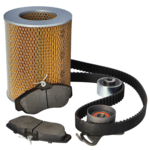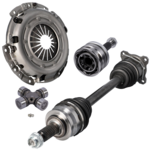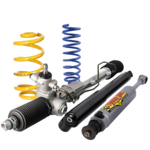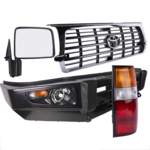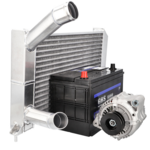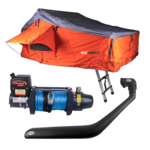Here at Euro4x4parts we aim to encourage off-roading as much as possible. Learning how to handle your 4x4 out there in the field is very important.
This article will give you a brief overview of some basic off-roading skills but is certainly not designed as a substitute for the precious techniques you can learn on an off-road driving course organised by an official training centre.
IMPORTANT
The photos of vehicles in use in this article were taken during competitions and / or on private grounds and / or abroad.
Euro4x4parts would like to remind you of article L 362-1 of the French Environmental Code states that: "In order to ensure the protection of natural areas, the circulation of motor vehicles is prohibited outside of the roads classified for public use by the state and local authorities, rural roads and private roads open to public motor vehicle traffic ”.
What is a side slope?
Crossing a side slope can be a tense moment for 4x4 drivers.
The limits of the 4x4 are often those of the driver, but it is obviously necessary to always remain very vigilant. Beyond the degree of slope itself, there are other points that can put you and your 4x4 into difficulty.
- excessive speed can cause skidding and movement and therefore create a risk of overturning.
- the nature of the terrain may prevent you from sticking to your trajectory..
- unsuitable tyres for the type of terrain can mean lack of group and therefore loss of control.
- poor or tired suspension can lead to excessive body movement which will significantly increase the risk of overturning.
- The overall height of the 4x4 affects the centre of gravity. A 4x4 equipped with a laden roof rack or roof tent will have a higher centre of gravity and therefore a greater risk of overturning.
All of these factors need to be taken into account when tackling a side slope.

The side slope needs to be tackled with great care and attention.
How to handle a side slope?
The first rule is to enter the zone with minimal acceleration, refrain from pumping the pedal and therefore avoiding sudden jerks. Braking, sudden acceleration, excessive movement of the steering wheel must all be avoided.

Best practice is to steer the wheels in the same direction as the slope.
If you need to change your course, turn the steering wheel smoothly and gently to avoid skidding. If your vehicle slips from the front or rear or if you feel that the 4x4 is close to the point of tipping over, you should aim to calmly steer the vehicle down the slope.
If the 4x4 starts to slip on a side slope you must never turn the wheels up the slope otherwise you increase the risk of rolling over.
Parts
To play safe on a side slope your 4x4 needs to have good suspension and the correct tyres.
We offer a range of tyre to suit your requirements:
Thanks to Club Alternance and the Circuit de La Vilaine for the photos taken on their private grounds.
Please note: Euro4x4Parts publishes this information to help its customers but cannot be held responsible for the advice given here and practical consequences that ensue.
Do it yourself, you'll be even prouder! To help you out, Euro4x4parts shares its know-how and expertise in mechanics through 4X4XPERT: new products, technical sheets, and personalized tutorials... You've got the keys!
And because we also learn from your experiences, your feedback is essential. Let us know your thoughts and suggestions by email: 4x4xpert@euro4x4parts.com
Check out our complete catalogue of 4x4 parts and accessories!
All the photos in our articles are taken on authorized roads or tracks, private land, or during supervised competitions. Let's all do our part to preserve the environment!
Please note: Euro4x4parts publishes this information to help its customers, but cannot be held responsible for the advice given here and their consequences when used.








